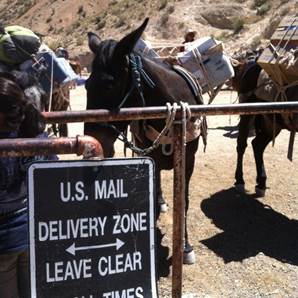Authored by: Junemarie Brandt, Research Analyst Postal History, 29 years in service
In 2014, I visited the Supai, Arizona, Post Office™ facility—the last Post Office™ in the U.S. receiving mail by mule. To most Americans, communication in 2016 is fast, and convenient. Groceries, electronics and other consumer goods can be ordered online and quickly brought to your door. But in Arizona, there is still a remote village where no motorized vehicles travel the unpaved streets and where the nearest supermarket is 120 miles away.
The only means of transport into the town for residents, visitors and goods is by limited, expensive helicopter trips, or on foot or by four-footed carriers. In Supai, the main means of communication and supply is via the U.S. Postal Service, with incoming and outgoing mail transported by mule train.
The 2010 census counted 208 residents in the village of Supai, which is located on the Havasupai Indian Reservation. The Havasupai are one of the smallest federally recognized tribal nations, and have resided within the Grand Canyon for more than 800 years. The name Havasupai means “people of the blue-green water”, referring to the turquoise waters of Havasu Creek which cascade into spectacular waterfalls about two miles past the village.
A string of mules accompanied by a wrangler on horseback makes the 16-mile round trip into the Grand Canyon six days a week. But for the USPS contractor the journey is much longer, picking up mail at Peach Springs, Arizona, and trucking it along 60 miles of a desolate road maintained by the federal Bureau of Indian Affairs. The road ends at Hualapai Hilltop, where the eight mile trail to Supai begins. No vehicles are permitted.
At the trailhead, I saw a sturdy pipe fence, with a group of mules tied to it, bearing a sign saying “U.S. Mail Delivery Zone—Leave Clear at All Times.” As a child I read about Grand Canyon mail being transported by mules, but assumed that practice had been phased out, like Special Delivery and aerograms. Near the mules were USPS bins holding a typical assortment of letters and flats but also some items you don’t usually see in the mail: cases of water and soda, large boxes of canned goods and multi-packs of household paper supplies. The mules waited patiently while these unwieldy parcels were packed onto their backs.
The Peach Springs Post Office™ facility has a unique feature– a walk in freezer to accommodate packages waiting to be delivered to Supai. The Havasupai tribe contracts with a grocery company to mail all manner of food and goods to the town. Many of these items are trucked directly to Hualapai Hilltop. The rest are delivered to Peach Springs every Tuesday and kept frozen until they are dispatched down the trail. While there is no way to keep items cold on the way down, the majority of the perishables are destined to one of Supai’s two businesses, and picked up as soon as the mail arrives.
In the first mile, the Havasupai Trail drops more than a thousand feet through a series of switchbacks. While descending this section, I heard the clatter of hoof beats behind me as the lead two mules came trotting briskly around the bend. Their slower companions followed, all of them surefootedly navigating the rocky surface of the steep trail. Last of all came the wrangler on horseback, confident that the mules knew the way and missing the worst of the dust by hanging back a bit.
After the steep descent, the trail goes follows the floor of the canyon, passing spectacular rock formations before arriving at Supai.
I didn’t see the mules being unloaded at the Supai Post Office™, but I can imagine how different it is from the mail arrival at the Post Offices in Pennsylvania where I’ve worked. The office is very small, but keeps busy during the six hours it’s open each day with incoming packages, visitors shipping camping gear out (to avoid hauling it back up the trail) and customers wanting to obtain the unique Mule Mail postmark. While the town has only a few hundred residents, over 20,000 people a year pass through the town on their way to Havasu Falls.
There are helicopter trips in and out of Supai four days a week in summer and two weekly trips during winter months. Weight considerations and expense are deterrents to this method of transporting parcels. High winds often force the helicopter trips to be canceled, but it is very rare that the mule train has been unable to complete the trip.
Watching the mules carry the mail gave me a sense of how difficult it was to move mail and supplies in the days before trucks or even trains connected the nation. It provided a look at how in this age of electronic communications the U.S. Postal Service provides a vital connection to residents in isolated communities. Despite the many innovations in mail processing, transportation and delivery, there are situations where an old fashioned method gives the best service to our customers.
